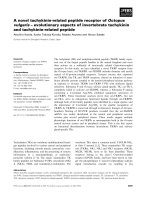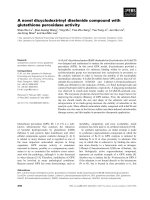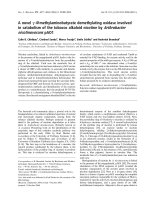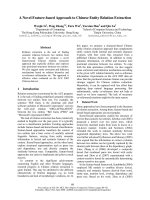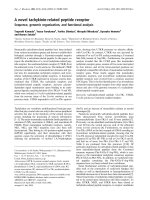Báo cáo khoa học: A novel transmembrane topology of presenilin based on reconciling experimental and computational evidence pptx
Bạn đang xem bản rút gọn của tài liệu. Xem và tải ngay bản đầy đủ của tài liệu tại đây (265.07 KB, 7 trang )
A novel transmembrane topology of presenilin based
on reconciling experimental and computational evidence
Anna Henricson, Lukas Ka
¨
ll and Erik L. L. Sonnhammer
Center for Genomics and Bioinformatics, Karolinska Institutet, Stockholm, Sweden
Presenilins (PSs) are transmembrane (TM) proteins that
are highly conserved throughout evolution. Elucidating
the TM topology of PSs is vital for understanding their
function. Several different models have been suggested
based on different experimental findings. It is not poss-
ible to produce a membrane topology model that agrees
with all published data. In humans there are two PSs
(PS1 and PS2) whose protein sequences are > 65%
identical to each other. Mutations in these genes cause
the majority of early onset familial Alzheimer’s disease
cases. PSs are also involved in the proteolytic process-
ing of the Notch receptor, which is responsible for
critical signaling events during development. Other sub-
strates have also been identified and there are probably
still more to discover [1,2].
PSs are part of c-secretase, a multisubunit protease
that also entails nicastrin, aph-1 and pen-2 [3,4]. This
complex is responsible for the intramembrane proteo-
lysis of type I membrane proteins, such as amyloid-b
precursor protein (APP) and Notch. PS has 10
Keywords
presenilin; c-secretase; presenilin-like
protein; topology prediction; transmembrane
topology
Correspondence
E. Sonnhammer, Center for Genomics and
Bioinformatics, Karolinska Institutet,
S-171 77 Stockholm, Sweden
Fax: +46 8337983
Tel: +46 852486395
E-mail:
(Received 25 January 2005, revised 22
March 2005, accepted 31 March 2005)
doi:10.1111/j.1742-4658.2005.04691.x
The transmembrane topology of presenilins is still the subject of debate
despite many experimental topology studies using antibodies or gene
fusions. The results from these studies are partly contradictory and conse-
quently several topology models have been proposed. Studies of preseni-
lin-interacting proteins have produced further contradiction, primarily
regarding the location of the C-terminus. It is thus impossible to produce
a topology model that agrees with all published data on presenilin. We
have analyzed the presenilin topology through computational sequence
analysis of the presenilin family and the homologous presenilin-like pro-
tein family. Members of these families are intramembrane-cleaving aspar-
tyl proteases. Although the overall sequence homology between the two
families is low, they share the conserved putative active site residues and
the conserved ‘PAL’ motif. Therefore, the topology model for the preseni-
lin-like proteins can give some clues about the presenilin topology. Here
we propose a novel nine-transmembrane topology with the C-terminus in
the extracytosolic space. This model has strong support from published
data on c-secretase function and presenilin topology. Contrary to most
presenilin topology models, we show that hydrophobic region X is prob-
ably a transmembrane segment. Consequently, the C-terminus would be
located in the extracytosolic space. However, the last C-terminal amino
acids are relatively hydrophobic and in conjunction with existing experi-
mental data we cannot exclude the possibility that the extreme C-terminus
could be buried within the c-secretase complex. This might explain the
difficulties in obtaining consistent experimental evidence regarding the
location of the C-terminal region of presenilin.
Abbreviations
APP, amyloid-b precursor protein; CTF, C-terminal fragment; ER, endoplasmic reticulum; GPCR, G protein-coupled receptor; HR, hydrophobic
region; IMPAS, intramembrane proteases; NTF, N-terminal fragment; PS, presenilin; PSH, presenilin-homolog; PSL, presenilin-like; SPP,
signal peptide peptidase; TLN, telencephalin; TM, transmembrane.
FEBS Journal 272 (2005) 2727–2733 ª 2005 FEBS 2727
hydrophobic regions (HRs), which may or may not be
true TM regions. In the c-secretase complex, PS exists
in its active form as an N- and C-terminal fragment
(NTF and CTF, respectively) heterodimer. Endoproteo-
lysis of PS by an unknown ‘presenilinase’ results in
these two fragments [5–7]. The major site of endopro-
teolytic cleavage in PS1 is between T291 and M292 [5],
which is located in HRVII. The first evidence that the
NTF–CTF heterodimers are the biologically active
form of PS and part of the c-secretase complex came
from inhibition studies using transition state analogues
designed to target the diaspartyl putative active site of
the protease [8,9]. The two conserved aspartate residues
are located in HRVI and HRVIII, respectively (D257
and D385 in PS1). They have been shown to be
required for c-secretase activity [10]. It has also been
shown that the PS C-terminus is involved in c-secretase
complex assembly and activity [11–16] and is required
for endoplasmic reticulum (ER) retention [13]. It is the
conserved ‘PAL’ sequence in the C-terminal part of the
protein that is believed to be essential for the activity.
In addition, a wide range of PS interacting proteins
have been identified [17].
All previously proposed PS topology models agree
that HRI–VI are true TM regions. The debate ques-
tions which of HRVII–X are true TM regions, and
also the location of the N- and C-termini. It is imposs-
ible to produce a membrane topology model that con-
curs with all previously published models. Most
studies conducted are gene fusion experiments using
different reporters to indicate cytosolic or noncytosolic
location. Such analyses are known to suffer frequently
from artifacts induced by the truncation of the protein
studied and the nature of the reporter gene used, and
therefore these studies must always be interpreted with
caution. Antibody experiments on native proteins have
been performed by Doan et al. [18] and Dewji et al.
[19,20]. Although antibodies are generally considered
more reliable, these two studies produced contradict-
ory results.
The first and most widely accepted model for PS
topology is the eight-TM model (excluding HRVII and
HRX) with both the N- and C-termini located in the
cytosol [21,22]. The experimental results from one anti-
body study supported this model, while at the same time
the authors also speculated about several different pos-
sible topology models [18]. A seven-TM model with an
extracytosolic N-terminus has also been proposed
[19,20]. Other models that have been suggested include a
six-TM model with cytosolic N- and C-termini [23], and
a ‘seven-TM and one membrane-embedded’ model with
an extracytosolic C-terminus [24]. The eight-TM model
is primarily based on studies on the Caenorhabditis
elegans ortholog of human PS, Sel-12. The other studies
have mainly used human PS1, and to some extent
human PS2. However, the topology of both human and
worm PSs is considered to be the same.
Recently, a new family of presenilin-like (PSL) pro-
teases (also called presenilin-homologs, PSH; intra-
membrane proteases, IMPAS) has emerged [25–27]. In
humans there are five members of this family, the best
known of which is the SPP (signal peptide peptidase).
These proteins were discovered due to their sequence
homology with PSs. Although the overall sequence
homology between the PSs and PSLs is low, they share
the conserved aspartate residues that are presumed to
be the active site, and the conserved PAL sequence in
the C-terminus. Indeed, SPP has been identified as an
aspartyl protease [27]. The topology of the PSL pro-
teins has been predicted to be a nine-TM topology
with the N-terminus in the extracytosolic space and
the C-terminus in the cytosol [28,29]. The aspartate
residues are located in TM regions six and seven. This
topology has recently been verified experimentally [30].
When comparing the performance of topology pre-
diction methods and low-resolution experiments (such
as gene fusion studies and antibody experiments), it
has been shown that most predictors are not signifi-
cantly less accurate than low-resolution experiments
[31]. The conflicting results from published studies on
PS topology illustrate the limitations of low-resolu-
tion experiments. In this study we have used compu-
tational prediction methods to analyze PS topology,
and have combined these results with previous data
from low-resolution experiments and functional data
on c-secretase to produce a novel topology model
that is well supported by both prediction methods
and experimental results. We propose a novel nine-
TM topology model with the C-terminus in the
extracytosolic space and the two putative active site
aspartate residues in TM regions six and seven,
respectively.
Results and Discussion
All of the experimentally inferred topology models
agree that HRI–VI are indeed TM regions [18–24]. A
majority of models agree on the localization of the
N-terminus and the loops between HRI and HRVI
[18,21–24]. Only one model suggests that the N-termi-
nus is located in the extracytosolic space [19,20], lead-
ing to opposite localization of the loops between HRI
and HRVI compared to the other models. Accumula-
tions of contradictory results are found in the C-ter-
minal part, and consequently several models have been
proposed.
Transmembrane topology of presenilin A. Henricson et al.
2728 FEBS Journal 272 (2005) 2727–2733 ª 2005 FEBS
We analyzed the PS sequences with five different
predictors using the sfinx tool [32]. Figure 1A shows
the output for human PS1. The results for the other
PS sequences were essentially the same (not shown).
The major insight is that HRX is probably a TM
region, which is not the case in most previously pub-
lished models, including the most widely accepted
eight-TM model [21,22]. A minority of the methods
predicts that HRVIII is a TM region, when used with
default settings. hmmtop2.1 considers HRVIII to be a
TM region, whereas memsat predicts both HRVII and
HRVIII to be TM regions. However, the hypothesis
that PS is an aspartyl protease performing intramem-
brane proteolysis of its substrates strongly suggests
that the two putative active site aspartate residues are
probably located in TM regions. Therefore, we carried
out Phobius’ [33] constrained prediction with both
aspartate residues constrained to be in TM segments.
The result was a nine-TM topology with the C-termi-
nus in the extracytosolic space (Figs 1A and 2B). This
is identical to the topology predicted by hmmtop2.1.
This topology was essentially consistent for all PS
sequences analyzed.
Our model is supported by 70% of the experiment-
ally determined loop locations (Fig. 2B). The main
conflicts between our model and those proposed previ-
ously concern HRX and to some extent HRVIII.
There are several grounds for HRVIII being a TM
region. The most compelling evidence comes from
studies showing that the two conserved aspartate resi-
dues in HRVI and HRVIII indeed seem to be the act-
ive site [8–10]. The proteolysis that these residues
perform is intramembrane, implying that they prob-
ably are located in TM regions. The relatively weak
hydrophobicity of HRVIII can be explained by this
embedded catalytic moiety. Furthermore, the mem-
brane topology of the PSL family supports that the
putative active site aspartate residues are located in
adjacent TM regions (Fig. 1B) [28–30]. Finally, one of
the previously published PS topology models supports
B
100
200
300
400
A
Hydrophobic region (HR)
I
II
III
IV
V
VI
VII
VIII
IX
Phobius
TMHMM2.0
PHDhtm
HMMTOP2.1
MEMSAT
Kyte-Doolittle
Phobius
TMHMM2.0
PHDhtm
HMMTOP2.1
MEMSAT
Kyte-Doolittle
100
200
300
400 500
D
D
PAL
Cytosolic
Extracytosolic
Signal peptide
Phobius
constrained
I
II
III
IV
V
VI
VII
VIII
IX
X
D
D
PAL
Fig. 1. Output from SFINX for human presenilin 1 and presenilin-like protein 2. (A) Presenilin 1 (PS1) (UniProt number P49768) has 10 hydro-
phobic regions (HRs) (indicated in Roman numerals). All topology predictors predict that HRX is a transmembrane (TM) region. A majority of
the predictors do not predict HRVIII to be a TM region, because its hydrophobicity is relatively weak. However, when using Phobius con-
strained prediction w ith the two putative active site aspartate residues constrained to be in a TM segment, Phobius predicts a nine-TM
model with the C-terminus in the extracytosolic space. The aspartate residues are located in TM regions six and seven (D257 and D385 in
PS1, indicated with ‘D’). This topology is also predicted by
HMMTOP2.1 without using constrained prediction. (B) Presenilin-like protein 2
(PSL2) (UniProt number Q8TCT8) has nine HRs (indicated in Roman numerals), and a putative N-terminal signal peptide. All topology predic-
tors predict the same topology, nine TM regions with the C-terminus in the cytosol. The putative active site aspartate residues are located
in TM regions six and seven (D351 and D412 in PSL2, indicated with ‘D’). Phobius is the only membrane topology predictor that also can
predict signal peptides. Other predictors can mistake the signal peptide for a TM region, as
MEMSAT does in this example. The conserved
PAL motif is indicated with ‘PAL’ (residues 433–435 in PS1, 463–465 in PSL2).
A. Henricson et al. Transmembrane topology of presenilin
FEBS Journal 272 (2005) 2727–2733 ª 2005 FEBS 2729
HRVIII as a TM region [21,22]. In our model, as well
as in the latter, the orientation of the PS active site is
inverted compared to the PSL. A rationale for this is
that the PS substrates are of inverse orientation com-
pared to PSL substrates; they are type I and type II
membrane proteins, respectively [1,2].
There are several reasons why we believe that HRX
is a TM region. Undoubtedly, the membrane topology
model for the PSL proteins [28–30] supports HRX as
a TM region (Fig. 1B). The PAL motif that is con-
served between the PS and PSL is located in the prox-
imity of, or within, HRX. In addition, HRX is a
strongly hydrophobic region and all the predictors
consider it to be a TM region. The PAL sequence in
the C-terminus has been shown to be essential for
c-secretase activity [11–13,15,16]. In fact, it may consti-
tute part of the active site, as mutations in these resi-
dues exhibit the same phenotypes as mutations in the
aspartate residues. This implies that the PAL sequence
might be located in a TM region. The C-terminus has
also been shown to interact with a number of other
proteins, which could give an indication as to whether
it is located in the cytosol or extracytosolic space. One
of the members of the c-secretase complex, nicastrin,
has been shown to bind at the C-terminus of PS [13].
The PS binding site in nicastrin is likely to be located
in its TM region, suggesting that the PS C-terminus
dives into or penetrates the membrane. Telencephalin
(TLN) and APP have also been shown to interact with
PS. Once again, PS binds with its C-terminus to the
TM domain of TLN and APP [34]. Furthermore, the
topology model proposed by Nakai et al. supports
HRX as a TM region [24].
In the model proposed here, only approximately 14
amino acid residues in the C-terminus are located in
the extracytosolic space. Considering the available
experimental data and the fact that these residues are
relatively hydrophobic, it is possible that the extreme
C-terminus might be buried in the c-secretase com-
plex. The PS C-terminus has also been shown to be
required for ER retention [13]. The sequence identi-
fied by Kaether et al. consists of 22 amino acids that
include the PAL motif and HRX, and it is well con-
served between species. As noted by Kaether et al.
this sequence is not similar to any known cytoplas-
mic ER retention signal. However, subunits of multi-
protein complexes possess retention signals in their
TM domains, which do not have the classical three-
to-four amino acid motif. These retention signals pre-
vent the export of unassembled subunits from the
ER. Once the complex is assembled, the retention
signal is masked and the protein complex can be
exported. In another study the PS C-terminus was
also found to be required for efficient transport [35],
however, no details regarding the experiment were
given.
A
B
Fig. 2. Presenilin topology models. (A) Sum-
mary of experimental data from low-resolu-
tion studies on presenilin (PS) topology.
Different regions of PS or single residues
have been experimentally determined to be
either in the extracytosolic or cytosolic
space. The protein sequence shown is
human PS1 (UniProt number P49768).
When human PS2 or Sel-12 (UniProt num-
bers P49810 and P52166, respectively) had
been analyzed, the positions were correla-
ted to human PS1. (B) Our proposed nine-
transmembrane (TM) topology. The TM
regions correspond to hydrophobic region
(HR) I–VI and HRVIII–X. The N-terminus and
the long loop are in the cytosol, whereas
the C-terminus is located in the extracytoso-
lic space. The putative active site aspartate
residues are located in TM regions six and
seven (indicated with ‘D’). HRs are indicated
in Roman numerals.
Transmembrane topology of presenilin A. Henricson et al.
2730 FEBS Journal 272 (2005) 2727–2733 ª 2005 FEBS
Altogether, there are experimental data that support
HRX as a TM region. At the same time, there are
experimental studies that contradict HRX as a TM
region. Only the topology model by Nakai et al. sup-
ports HRX as a TM region, although Doan et al. [18]
speculate that HRX might be a TM region without
presenting any experimental evidence. A reason why
HRX has not been considered a TM segment is that in
most gene fusion studies the loop before HRX and the
C-terminus were determined to be located in the cyto-
sol. However, as pointed out by Nakai et al. this could
be due to the nature of the reporter gene used. The
C-terminus of PS is relatively hydrophobic and fusion
to a reporter gene with a relatively hydrophobic N-ter-
minus could create an artificial TM region at the fusion
point, leading to incorrect localization of the reporter
gene. The contradicting results regarding the C-ter-
minal location from the antibody studies [18–20] might
be an artifact due to the overexpression of PS.
There are also protein interaction experiments that
indicate a cytosolic location of the C-terminus. PS has
a potential PDZ domain recognition sequence in its
extreme C-terminus, and PDZ domain-containing pro-
teins that recognize PS through this motif have been
reported [36–39]. Taken together, the experimental
data regarding the location of the C-terminus is con-
flicting. We believe that the topology predictions for
PS and the confirmed topology for the PSL proteins,
combined with published PS experimental studies, sug-
gest that the C-terminus is located in the extracytosolic
space. A possible explanation for the conflicting results
is that the C-terminus could be buried in the c-secret-
ase complex, as discussed previously. Another possibil-
ity, although less likely, is that there are two molecular
species of PS coexisting in the cell differing in the loca-
tion of the C-terminus. This would implicate that the
C-terminal region could interact with factors in both
the cytosol and the extracytosolic space.
The antibody studies by Dewji et al. [19,20] have the
most conflicts with our model. They propose a seven-
TM topology model with the N-terminus and the long
loop between HRVII and HRVIII located in the extra-
cytosolic space, and consequently the C-terminus in
the cytosol. The localization of the N-terminus and the
long loop not only conflicts with our model, but also
with all other experimental studies. The proposition by
Dewji et al. [19] that PSs are G protein-coupled recep-
tors (GPCRs) and have a seven-TM topology with an
extracytosolic N-terminus is unlikely due to several
reasons. First, there are eight very hydrophobic regions
in the PS sequence (HRI–VI and HRIX–X). Second,
the N-terminus is probably located in the cytosol as
shown by four experimental studies [18,21–24] and our
analysis. Third, the PSs do not exhibit topological
characteristics commonly found in different subfamilies
of known GPCRs. For example, loop six (extracytoso-
lic loop three) in the Dewji et al. model is very long
(approximately 140 residues), which has not been
found in GPCRs [40]. Also, the first cytosolic loop is
longer than those usually found in GPCRs.
In summary, we propose a novel nine-TM topology
for the PSs with the C-terminus located in the extracyto-
solic space (Fig. 2B). The nine TM regions correspond
to HRI–VI and HRVIII–X. The putative active site
aspartate residues are located in TM regions six and
seven in our model. It is impossible to decide on a single
topology model that agrees with all published experi-
mental data on PSs. Determining their topology is crit-
ical for understanding their normal and pathogenic
functions. However, the ultimate solution to the topol-
ogy of PSs can only be achieved through atomic reso-
lution studies of the whole c-secretase complex.
Meanwhile, we offer an alternative topology model of
PSs, reconciling the previously published experimental
data with results from our topology prediction analysis.
Experimental procedures
The PS sequences in the full alignment from the Pfam
database, version 16.0, were analyzed, excluding sequence
fragments. Membrane topology for each sequence was pre-
dicted with five different methods, and the sfinx tool [32]
(http://sfinx.cgb.ki.se/) was used to display the results. The
predictors were Phobius [33], tmhmm2.0 [41], PHDhtm
[42], hmmtop2.1 [43] and memsat [44]. In addition, a Kyte–
Doolittle hydrophobicity curve [45] was constructed for
each PS sequence. phobius also predicts N-terminal signal
peptides. Each program was used with default settings. The
sequences were also analyzed using phobius constrained
predictions with the two putative active site aspartate resi-
dues constrained to be in TM segments.
Acknowledgements
This work was supported by a grant from the Swedish
Knowledge Foundation and Pfizer Corporation to
A.H., and L.K., and by grants from Pfizer Corpora-
tion to E.S.
References
1 Xia W & Wolfe MS (2003) Intramembrane proteolysis
by presenilin and presenilin-like proteases. J Cell Sci
116, 2839–2844.
2 Martoglio B & Golde TE (2003) Intramembrane-cleav-
ing aspartic proteases and disease: presenilins, signal
A. Henricson et al. Transmembrane topology of presenilin
FEBS Journal 272 (2005) 2727–2733 ª 2005 FEBS 2731
peptide peptidase and their homologs. Hum Mol Genet
12 Spec 2 , R201–R206.
3 Kimberly WT & Wolfe MS (2003) Identity and function
of gamma-secretase. J Neurosci Res 74, 353–360.
4 Fraering PC, Ye W, Strub JM, Dolios G, LaVoie MJ,
Ostaszewski BL, van Dorsselaer A, Wang R, Selkoe DJ
& Wolfe MS (2004) Purification and characterization of
the human gamma-secretase complex. Biochemistry 43,
9774–9789.
5 Steiner H, Romig H, Pesold B, Philipp U, Baader M,
Citron M, Loetscher H, Jacobsen H & Haass C (1999)
Amyloidogenic function of the Alzheimer’s disease-asso-
ciated presenilin 1 in the absence of endoproteolysis.
Biochemistry 38, 14600–14605.
6 Thinakaran G, Borchelt DR, Lee MK, Slunt HH, Spit-
zer L, Kim G, Ratovitsky T, Davenport F, Nordstedt
C, Seeger M et al. (1996) Endoproteolysis of presenilin
1 and accumulation of processed derivatives in vivo.
Neuron 17, 181–190.
7 Jacobsen H, Reinhardt D, Brockhaus M, Bur D,
Kocyba C, Kurt H, Grim MG, Baumeister R &
Loetscher H (1999) The influence of endoproteolytic
processing of familial Alzheimer’s disease presenilin 2
on abeta42 amyloid peptide formation. J Biol Chem
274, 35233–35239.
8 Li YM, Xu M, Lai MT, Huang Q, Castro JL,
DiMuzio-Mower J, Harrison T, Lellis C, Nadin A,
Neduvelil JG et al. (2000) Photoactivated gamma-secret-
ase inhibitors directed to the active site covalently label
presenilin 1. Nature 405, 689–694.
9 Esler WP, Kimberly WT, Ostaszewski BL, Diehl TS,
Moore CL, Tsai JY, Rahmati T, Xia W, Selkoe DJ &
Wolfe MS (2000) Transition-state analogue inhibitors of
gamma-secretase bind directly to presenilin-1. Nat Cell
Biol 2, 428–434.
10 Wolfe MS, Xia W, Ostaszewski BL, Diehl TS, Kimberly
WT & Selkoe DJ (1999) Two transmembrane aspartates
in presenilin-1 required for presenilin endoproteolysis
and gamma-secretase activity. Nature 398, 513–517.
11 Bergman A, Laudon H, Winblad B, Lundkvist J &
Naslund J (2004) The extreme C terminus of presenilin
1 is essential for gamma-secretase complex assembly
and activity. J Biol Chem 279, 45564–45572.
12 Wang J, Brunkan AL, Hecimovic S, Walker E & Goate
A (2004) Conserved ‘PAL’ sequence in presenilins is
essential for gamma-secretase activity, but not required
for formation or stabilization of gamma-secretase com-
plexes. Neurobiol Dis 15, 654–666.
13 Kaether C, Capell A, Edbauer D, Winkler E, Novak B,
Steiner H & Haass C (2004) The presenilin C-terminus
is required for ER-retention, nicastrin-binding and
gamma-secretase activity. Embo J 23, 4738–4748.
14 Tomita T, Takikawa R, Koyama A, Morohashi Y,
Takasugi N, Saido TC, Maruyama K & Iwatsubo T
(1999) C terminus of presenilin is required for
overproduction of amyloidogenic Abeta42 through sta-
bilization and endoproteolysis of presenilin. J Neurosci
19, 10627–10634.
15 Tomita T, Watabiki T, Takikawa R, Morohashi Y,
Takasugi N, Kopan R, De Strooper B & Iwatsubo T
(2001) The first proline of PALP motif at the C termi-
nus of presenilins is obligatory for stabilization, complex
formation, and gamma-secretase activities of presenilins.
J Biol Chem 276, 33273–33281.
16 Takasugi N, Takahashi Y, Morohashi Y, Tomita T &
Iwatsubo T (2002) The mechanism of gamma-secretase
activities through high molecular weight complex forma-
tion of presenilins is conserved in Drosophila melanoga-
ster and mammals. J Biol Chem 277, 50198–50205.
17 Chen Q & Schubert D (2002) Presenilin-interacting pro-
teins. Expert Rev Mol Med 2002, 1–18.
18 Doan A, Thinakaran G, Borchelt DR, Slunt HH,
Ratovitsky T, Podlisny M, Selkoe DJ, Seeger M, Gandy
SE, Price DL & Sisodia SS (1996) Protein topology of
presenilin 1. Neuron 17, 1023–1030.
19 Dewji NN, Valdez D & Singer SJ (2004) The preseni-
lins turned inside out: implications for their structures
and functions. Proc Natl Acad Sci USA 101, 1057–
1062.
20 Dewji NN & Singer SJ (1997) The seven-transmembrane
spanning topography of the Alzheimer disease-related
presenilin proteins in the plasma membranes of cultured
cells. Proc Natl Acad Sci USA 94, 14025–14030.
21 Li X & Greenwald I (1996) Membrane topology of the
C. elegans SEL-12 presenilin. Neuron 17, 1015–1021.
22 Li X & Greenwald I (1998) Additional evidence for an
eight-transmembrane-domain topology for Caenorhabdi-
tis elegans and human presenilins. Proc Natl Acad Sci
USA 95, 7109–7114.
23 Lehmann S, Chiesa R & Harris DA (1997) Evidence for
a six-transmembrane domain structure of presenilin 1.
J Biol Chem 272, 12047–12051.
24 Nakai T, Yamasaki A, Sakaguchi M, Kosaka K, Miha-
ra K, Amaya Y & Miura S (1999) Membrane topology
of Alzheimer’s disease-related presenilin 1. Evidence for
the existence of a molecular species with a seven mem-
brane-spanning and one membrane-embedded structure.
J Biol Chem 274, 23647–23658.
25 Grigorenko AP, Moliaka YK, Korovaitseva GI &
Rogaev EI (2002) Novel class of polytopic proteins with
domains associated with putative protease activity.
Biochemistry (Mosc) 67, 826–835.
26 Ponting CP, Hutton M, Nyborg A, Baker M, Jansen
K & Golde TE (2002) Identification of a novel family
of presenilin homologues. Hum Mol Genet 11, 1037–
1044.
27 Weihofen A, Binns K, Lemberg MK, Ashman K &
Martoglio B (2002) Identification of signal peptide pep-
tidase, a presenilin-type aspartic protease. Science 296,
2215–2218.
Transmembrane topology of presenilin A. Henricson et al.
2732 FEBS Journal 272 (2005) 2727–2733 ª 2005 FEBS
28 Grigorenko AP, Moliaka YK, Soto MC, Mello CC &
Rogaev EI (2004) The Caenorhabditis elegans IMPAS
gene, imp-2, is essential for development and is func-
tionally distinct from related presenilins. Proc Natl Acad
Sci USA 101, 14955–14960.
29 Henricson A, Sonnhammer EL, Baillie DL & Gomes
AV (2004) Functional characterization in Caenorhabdi-
tis elegans of transmembrane worm-human orthologs.
BMC Genomics 5, 85.
30 Friedmann E, Lemberg MK, Weihofen A, Dev KK,
Dengler U, Rovelli G & Martoglio B (2004) Consensus
analysis of signal peptide peptidase and homologous
human aspartic proteases reveals opposite topology of
catalytic domains compared with presenilins. J Biol
Chem 279, 50790–50798.
31 Chen CP, Kernytsky A & Rost B (2002) Transmem-
brane helix predictions revisited. Protein Sci 11, 2774–
2791.
32 Sonnhammer EL & Wootton JC (2001) Integrated gra-
phical analysis of protein sequence features predicted
from sequence composition. Proteins 45, 262–273.
33 Kall L, Krogh A & Sonnhammer EL (2004) A com-
bined transmembrane topology and signal peptide pre-
diction method. J Mol Biol 338, 1027–1036.
34 Annaert WG, Esselens C, Baert V, Boeve C, Snellings
G, Cupers P, Craessaerts K & De Strooper B (2001)
Interaction with telencephalin and the amyloid precur-
sor protein predicts a ring structure for presenilins.
Neuron 32, 579–589.
35 Nufer O, Guldbrandsen S, Degen M, Kappeler F,
Paccaud JP, Tani K & Hauri HP (2002) Role of cyto-
plasmic C-terminal amino acids of membrane proteins
in ER export. J Cell Sci 115, 619–628.
36 Gupta S, Singh R, Datta P, Zhang Z, Orr C, Lu Z,
Dubois G, Zervos AS, Meisler MH, Srinivasula SM
et al. (2004) The C-terminal tail of presenilin regulates
Omi ⁄ HtrA2 protease activity. J Biol Chem 279, 45844–
45854.
37 Ni CY, Yuan H & Carpenter G (2003) Role of the
ErbB-4 carboxyl terminus in gamma-secretase cleavage.
J Biol Chem 278, 4561–4565.
38 Lau KF, McLoughlin DM, Standen C & Miller CC
(2000) X11 alpha and x11 beta interact with presenilin-
1 via their PDZ domains. Mol Cell Neurosci 16,
557–565.
39 Xu X, Shi Y, Wu X, Gambetti P, Sui D & Cui MZ
(1999) Identification of a novel PSD-95 ⁄ Dlg ⁄ ZO-1
(PDZ)-like protein interacting with the C terminus of
presenilin-1. J Biol Chem 274, 32543–32546.
40 Inoue Y, Ikeda M & Shimizu T (2004) Proteome-wide
classification and identification of mammalian-type
GPCRs by binary topology pattern. Comput Biol Chem
28, 39–49.
41 Krogh A, Larsson B, von Heijne G & Sonnhammer EL
(2001) Predicting transmembrane protein topology
with a hidden Markov model: application to complete
genomes. J Mol Biol 305, 567–580.
42 Rost B, Fariselli P & Casadio R (1996) Topology
prediction for helical transmembrane proteins at 86%
accuracy. Protein Sci 5, 1704–1718.
43 Tusnady GE & Simon I (2001) The HMMTOP trans-
membrane topology prediction server. Bioinformatics 17,
849–850.
44 Jones DT, Taylor WR & Thornton JM (1994) A model
recognition approach to the prediction of all-helical
membrane protein structure and topology. Biochemistry
33, 3038–3049.
45 Kyte J & Doolittle RF (1982) A simple method for dis-
playing the hydropathic character of a protein. J Mol
Biol 157, 105–132.
Supplementary material
The following material is available from http://www.
blackwell-publishing.com/products/journals/suppmat/EJB/
EJB4691/EJB4691sm.htm
Table S1. Summary of experimental studies on preseni-
lin topology.
Table S2. Results from Phobius constrained predic-
tion.
A. Henricson et al. Transmembrane topology of presenilin
FEBS Journal 272 (2005) 2727–2733 ª 2005 FEBS 2733


